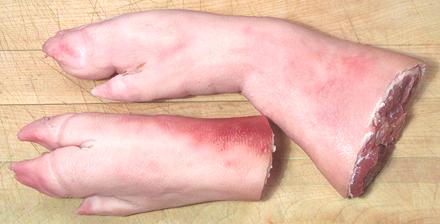
Pig feet are widely used throughout Europe, Asia, Mexico and parts of South America, both to add body to soups and stews and served on their own, or they may be pickled. They are one of the most prized parts of the pig. The photo shows the common form, just the foot, and the long form with hock. Feet run from 6-1/2 to 9 inches long and weighed between 14 ounces and 1-1/2 pounds. The "long foot" was 10 inches long and weighted 1 pound 11 ounces, but they can be longer and heavier.
Pig feet in the markets are from the hind legs - those from the front legs are small and mainly used to produce gelatin. Pig feet have very little fat and are almost all bone and protein.
More on Cuts of Pork.
Many markets pre-cut pig feet in various ways and pack them in foam trays. Other markets display them whole, but you can ask the meat man to cut them as you want them - there should be no charge for this - in fact, the meat men around here usually repeat the question to make sure I really do want them uncut.
In Europe, particularly the British Isles, and some other regions, pig feet are often heavily salted. These will need to be soaked at least overnight before cooking. Then they are rinsed, put in water and brought to a boil, then drained. Ignore that instruction for fresh American pig feet.
If you have whole feet and need them cut, Short Feet you can easily cut yourself. Use a razor sharp Chinese cleaver knife, driving it through with a soft faced mallet. In Long Feet the bone gets pretty hard at the big end. My cleaver knife, made in Massachusetts from the finest carbon steel (long before Nixon opened trade with China), can take it, but if yours is from China, perhaps not.
Some French recipes call for simmering slowly for 6 hours (or even more) before boning, but I find this excessive and have no trouble removing the bones after 3 hours of simmering. Maybe they have tougher pigs in France.